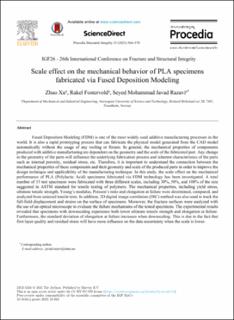| dc.description.abstract | Fused Deposition Modeling (FDM) is one of the most widely used additive manufacturing processes in the world. It is also a rapid prototyping process that can fabricate the physical model generated from the CAD model automatically without the usage of any tooling or fixture. In general, the mechanical properties of components produced with additive manufacturing are dependent on the geometry and the scale of the fabricated part. Any change in the geometry of the parts will influence the underlying fabrication process and inherent characteristics of the parts such as internal porosity, residual stress, etc. Therefore, it is important to understand the connection between the mechanical properties of these components and their geometry and scale of the produced parts in order to improve the design technique and applicability of the manufacturing technique. In this study, the scale effect on the mechanical performance of PLA (Polylactic Acid) specimens fabricated via FDM technology has been investigated. A total number of 15 test specimens were fabricated with three different scales, including 30%, 50%, and 100% of the size suggested in ASTM standard for tensile testing of polymers. The mechanical properties, including yield stress, ultimate tensile strength, Young’s modulus, Poisson’s ratio and elongation at failure were determined, compared, and analyzed from uniaxial tensile tests. In addition, 2D digital image correlation (DIC) method was also used to track the full-field displacement and strains on the surface of specimens. Moreover, the fracture surfaces were analyzed with the use of an optical microscope to evaluate the failure mechanisms of the tested specimens. The experimental results revealed that specimens with downscaling experience both lower ultimate tensile strength and elongation at failure. Furthermore, the standard deviation of elongation at failure increases when downscaling. This is due to the fact that first layer quality and residual stress will have more influence on the data uncertainty when the scale is lower. | en_US |

